Pioneer AVIC-F850BT User Manual [en, de, es, fr, it]
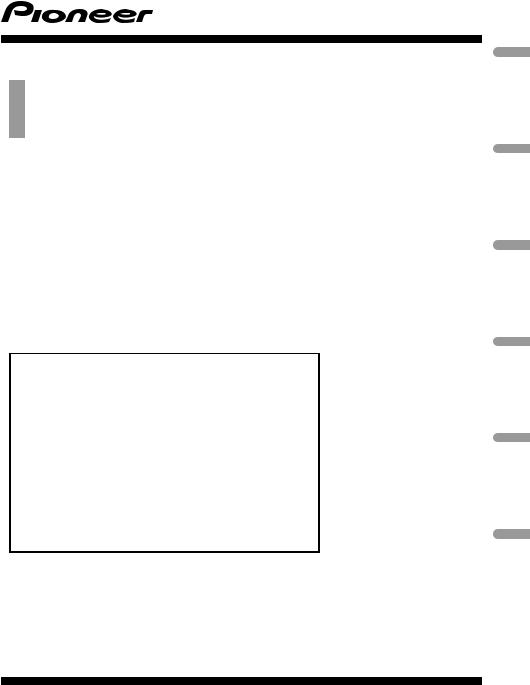
Installation Manual
Manuel d’installation
NAVIGATION AV SYSTEM
SYSTEME DE NAVIGATION AV
SISTEMA DI NAVIGAZIONE AV
SISTEMA DE NAVEGACIÓN AV
NAVIGATIONS-/AV-SYSTEM
AV NAVIGATIESYSTEEM
AVIC-F850BT
Some wiring and installation are described in the separate installation manual.
Certains câblages et procédés d’installation sont décrits dans le manuel d’installation séparé.
Alcuni dati di cablaggio e installazione sono descritti nel Manuale d’installazione separato.
En el manual de instalación independiente se describe parte del proceso de cableado e instalación.
Gewisse Verkabelungsund Installationsarbeiten sind in der separaten Einbauanleitung beschrieben.
Sommige bedradingsen installatie-informatie staat in de afzonderlijke installatiehandleiding.
Nederlands Deutsch Español Italiano Français English


 Contents
Contents
Precautions |
|
|
|
Your new navigation system and this |
|
||
manual |
3 |
|
|
Important safeguards |
3 |
|
|
Connecting the system |
|
||
Precautions before connecting the |
|
||
system |
5 |
|
|
Before installing this product 5 |
|
||
To prevent damage 6 |
|
|
|
– Notice for the blue/white lead |
6 |
||
– Notice for the violet/white lead |
6 |
||
Parts supplied 7 |
|
|
|
Installing the HDMI® cable holder 7 |
|
||
Connecting the system |
8 |
|
|
When connecting the Android™ device |
10 |
|||
When connecting to separately sold power |
||||
amp 12 |
|
|
|
|
When connecting a rear view camera |
14 |
|||
When connecting the external video |
|
|||
component 15 |
|
|
|
|
– |
Using an AV input (AV1) |
15 |
|
|
– |
Using an AV input (AV2) |
16 |
|
|
When connecting the rear display 16 |
|
|||
– |
When using a rear display connected to |
|||
|
rear video output |
16 |
|
|
Installation |
|
|
|
|
Precautions before installation |
17 |
|
||
To avoid electromagnetic interference |
17 |
|||
Before installing 17 |
|
|
|
|
Installing the navigation system |
18 |
|
||
– |
Installation notes |
18 |
|
|
Installing the GPS aerial |
19 |
|
|
|
– |
Installation notes |
19 |
|
|
– |
Parts supplied 19 |
|
|
|
–When installing the aerial inside the vehicle (on the dashboard or rear
shelf) 20
Installing the microphone 21
– |
Parts supplied 21 |
– |
Mounting on the sun visor 21 |
– |
Installation on the steering column 22 |
– |
Adjusting the microphone angle 22 |
 2
2 Engb
Engb

 Precautions
Precautions
Your new navigation |
Important safeguards |
|
system and this manual |
WARNING |
|
! The navigation features of this product |
||
Pioneer does not recommend that you install |
||
(and the rear view camera option if pur- |
your navigation system yourself. This pro- |
|
chased) are intended solely to aid you in |
duct is designed for professional installation |
|
the operation of your vehicle. It is not a sub- |
only. We recommend that only authorised |
|
stitute for your attentiveness, judgement |
Pioneer service personnel, who have special |
|
and care when driving. |
training and experience in mobile electro- |
|
! Never use this navigation system to route |
nics, set up and install this product. NEVER |
|
to hospitals, police stations, or similar facil- |
SERVICE THIS PRODUCT YOURSELF. In- |
|
ities in an emergency. Please call the ap- |
stalling or servicing this product and its con- |
|
propriate emergency number. |
necting cables may expose you to the risk of |
|
! Do not operate this navigation system (or |
electric shock or other hazards, and can |
|
the rear view camera option if purchased) if |
cause damage to the navigation system that |
|
doing so will divert your attention in any |
is not covered by warranty. |
|
way from the safe operation of your vehicle. |
|
|
Always observe safe driving rules and fol- |
! Read this manual fully and carefully before |
|
low all existing traffic regulations. If you ex- |
installing your navigation system. |
|
perience difficulty in operating the system |
! Keep this manual handy for future refer- |
|
or reading the display, park your vehicle in |
ence. |
|
a safe location and apply the handbrake be- |
! Pay close attention to all warnings in this |
|
fore making the necessary adjustments. |
manual and follow the instructions care- |
|
! This manual explains how to install this na- |
fully. |
|
vigation system in your vehicle. However, |
! This navigation system may in certain cir- |
|
some wiring and installation are described |
cumstances display inaccurate position of |
|
in the separate installation manual. Opera- |
your vehicle, the distance of objects shown |
|
tion of this navigation system is explained |
on the screen, and compass directions. In |
|
in a separate manual. |
addition, the system has certain limita- |
|
! Do not install this product where it may (i) |
tions, including the inability to identify one- |
|
obstruct the driver’s vision, (ii) impair the |
way streets, temporary traffic restrictions |
|
performance of any of the vehicle’s operat- |
and potentially unsafe driving areas. Please |
|
ing systems of safety features, including |
exercise your own judgement in the light of |
|
airbags, hazard lamp buttons, or (iii) impair |
actual driving conditions. |
|
the driver’s ability to safely operate the vehi- |
! As with any accessory in your vehicle’s in- |
|
cle. In some cases, it may not be possible |
terior, the navigation system should not di- |
|
to install this product because of the vehi- |
vert your attention from the safe operation |
|
cle type or the shape of the vehicle inter- |
of your vehicle as it may result in serious |
|
ior. |
injury or death. If you experience difficulty |
|
|
in operating the system or reading the dis- |
|
|
play, please make adjustments while safely |
|
|
parked. |
|
|
! Please remember to wear your seat belt at |
|
|
all times while operating your vehicle. If |
|
|
you are in an accident, your injuries can be |
|
|
considerably more severe if your seat belt |
|
|
is not properly fastened. |
Section
01
English
Engb  3
3

Section
01  Precautions
Precautions
!Certain country and government laws may prohibit or restrict the placement and use of this system in your vehicle. Please comply with all applicable laws and regulations
regarding the use, installation and operation of your navigation system.
 4
4 Engb
Engb
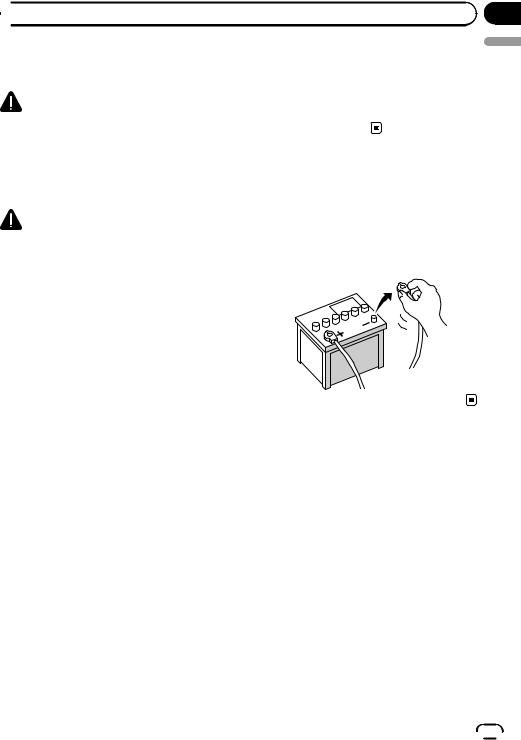
 Connecting the system
Connecting the system
Precautions before |
! Never feed power to other electronic pro- |
|
connecting the system |
ducts by cutting the insulation of the |
|
power supply lead of the navigation sys- |
||
|
||
WARNING |
tem and tapping into the lead. The current |
|
capacity of the lead will be exceeded, |
||
Do not take any steps to tamper with or dis- |
||
causing overheating. |
||
able the handbrake interlock system which |
||
|
||
is in place for your protection. Tampering |
|
|
with or disabling the handbrake interlock |
Before installing this product |
|
system could result in serious injury or |
||
death. |
! Use this unit with a 12-volt battery and ne- |
|
|
gative earthing only. Failure to do so may |
|
CAUTION |
result in a fire or malfunction. |
|
! If you decide to perform the installation |
! To avoid shorts in the electrical system, be |
|
yourself, and have special training and ex- |
sure to disconnect the (–) battery cable be- |
|
perience in the mobile electronics instal- |
fore installation. |
|
lations, please carefully follow all of the |
|
|
steps in the installation manual. |
|
|
! Secure all wiring with cable clamps or |
|
|
electrical tape. Do not allow any bare wir- |
|
|
ing to remain exposed. |
|
!It is extremely dangerous to allow cables to become wound around the steering column or gearstick. Be sure to install this product, its cables, and wiring away in such so that they will not obstruct or hinder driving.
!Make sure that the cables and wires will not interfere with or become caught in any of the vehicle’s moving parts, especially the steering wheel, gearstick, handbrake, sliding seat tracks, doors, or any of the vehicle’s controls.
!Do not route wires where they will be exposed to high temperatures. If the insulation heats up, wires may become damaged, resulting in a short circuit or malfunction and permanent damage to the product.
!Do not cut the GPS aerial cable to shorten it or use an extension to make it longer. Altering the aerial cable could result in a short circuit or malfunction.
!Do not shorten any leads. If you do, the protection circuit (fuse holder, fuse resistor or filter, etc.) may fail to work properly.
Section
02
English
Engb  5
5
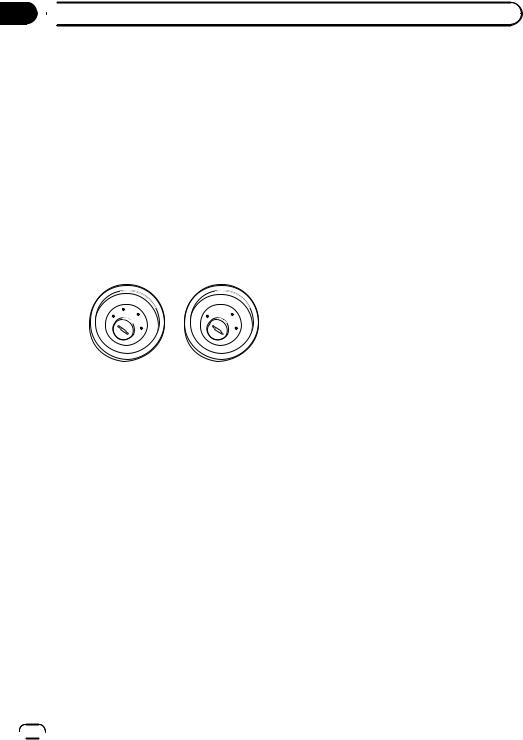
Section
02  Connecting the system
Connecting the system
To prevent damage
 WARNING
WARNING
!Use speakers over 50 W (output value) and between 4 W to 8 W (impedance value). Do not use 1 W to 3 W speakers for this
unit.
!When replacing the fuse, be sure to only use a fuse of the rating prescribed on this product.
!When disconnecting a connector, pull the connector itself. Do not pull the lead, as you may pull it out of the connector.
!This product cannot be installed in a vehicle without ACC (accessory) position on the ignition switch.
|
CC |
|
|
|
F |
A |
O |
F |
O |
|
||||
|
N |
N |
||
F |
|
|
F |
|
O |
|
|
O |
|
|
|
S |
|
S |
|
|
T |
|
T |
|
|
A |
|
A |
|
|
T |
|
T |
ACC position |
No ACC position |
|||
!To avoid short-circuiting, cover the disconnected lead with insulating tape. It is especially important to insulate all unused speaker leads, which if left uncovered may cause a short circuit.
!Refer to the owner’s manual for details on connecting the power amp and other units, then make connections accordingly.
!Since a unique BPTL circuit is employed, do not directly earth the * side of the speaker lead or connect the * side of another side of the speaker lead together. Be sure to connect the * side of the speaker lead to the * side of the speaker lead on this navigation system.
Notice for the blue/white lead
!When the ignition switch is turned on (ACC ON), a control signal is output through the blue/white lead. Connect to an external
power amp’s system remote control term-
inal, the auto-aerial relay control terminal, or the aerial booster power control terminal (max. 300 mA 12 V DC). The control signal is output through the blue/white lead, even if the audio source is switched off.
!Be sure not to use this lead as the power supply lead for the external power amps. Such connection could cause excessive current drain and malfunction.
!Be sure not to use this lead as the power supply lead for the auto-aerial or aerial booster. Such connection could cause excessive current drain and malfunction.
Notice for the violet/white lead
The violet/white lead must be connected so that the navigation system can detect whether the vehicle is moving forwards or backwards. Connect the violet/white lead to the lead whose voltage changes when the reverse gear is engaged. Unless connected, the sensor may not detect your vehicle travelling forwards/ backwards properly, and thus your vehicle position as detected by the sensor may not correspond to the actual position.
 6
6 Engb
Engb

 Connecting the system
Connecting the system
Parts supplied |
Installing the HDMI® cable |
|
holder |
|
1 Insert the lower tab of the HDMI cable |
|
holder into the groove of this product. |
|
Groove |
The navigation unit |
RCA connector |
|
|
Tab |
GPS aerial |
Microphone |
2 Insert the two upper tabs into the this |
|
|
|
|
|
product by pushing the HDMI cable holder. |
|
|
Tab |
HDMI cable holder |
|
|
p Use the HDMI cable holder when you connect this product with the separately sold App Connectivity Kit (CD-AH200).
p Never grip the holder tightly or use force when removing or attaching.
Section
02
English
Engb  7
7
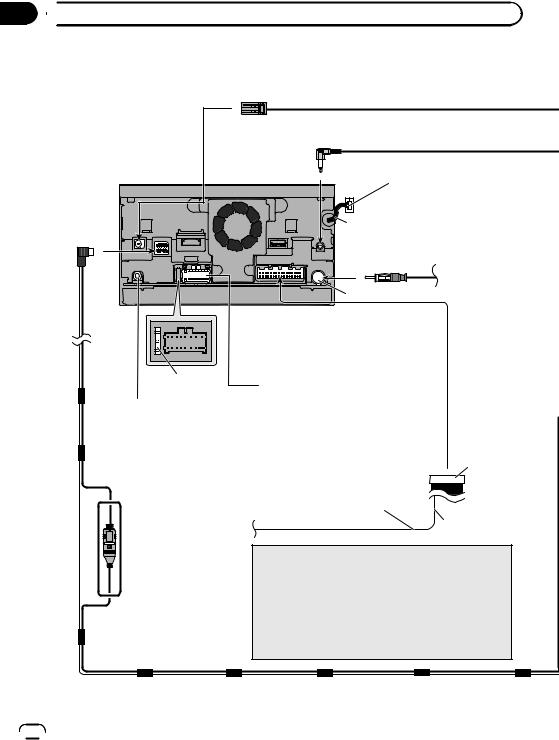
Section
02 Connecting the system Connecting the system
Connecting the system Connecting the system
The navigation unit
13 cm |
Vehicle Bus adapter input Please refer to the instruction manual for the Vehicle Bus adapter (sold separately).
Vehicle aerial
Aerial jack
Fuse (10 A)
Wired remote input Please refer to the instruction manual for the Hard-wired remote control adapter (sold separately).
(*2)
(*2)
If you use a USB storage device, pull out the plug and insert a USB storage device.
Power cord
For connection, refer to the wiring and installation manual separately supplied.
Yellow/black |
RCA connector |
If you use an equipment with mute |
|
function, connect that equipment to |
|
the Audio Mute lead. If not, keep this |
|
lead free of any connections. |
|
|
15 cm |
 Note
Note
Audio source will be set to mute or attenuate, while the following sounds will not be muted or attenuated. For details, refer to Operation Manual.
—voice guidance of the navigation
—incoming ringtone and incoming voice of the mobile phone that is connected to this navigation system via Bluetooth® wireless technology
 8
8 Engb
Engb

 Connecting the system
Connecting the system
 3.55 m
3.55 m
GPS aerial
 Microphone
Microphone
4 m
iPhone (*1)
(*1)
For details concerning operations and compatibility, refer to Operation Manual.
USB interface cable for iPod (sold separately)
WARNING
·To avoid the risk of accident and the potential violation of applicable laws, this product should never be used while the vehicle is being driven except for navigation purposes. And, also rear displays should not be in a location where it is a visible distraction to the driver.
·In some countries, the viewing of images on a display inside a vehicle even by persons other than the driver may be illegal. Where such regulations apply they must be obeyed and this product’s video source should not be used.
Section
02
English
Engb  9
9

Section
02  Connecting the system
Connecting the system
When connecting the Android™ device
Connecting an Android device with an MHL port
High Speed HDMI® Cable (*1) (Type A - A)
(sold separately)
HDMI 

 HDMI cable port
HDMI cable port
holder
MHL adapter (*1) (sold separately)
 USB cable (*1) (sold separately)
USB cable (*1) (sold separately)
USB port |
USB - micro USB cable (*1) |
|
(Type USB A - micro USB B) |
||
(1.6 A 5 V DC) |
||
(sold separately) |
||
(CHARGE ONLY) |
||
|
(*1)
For details of how to connect the separately sold App Connectivity Kit (CD-AH200), refer to the App Connectivity Kit manual.
 Notes
Notes
·When you connect the High Speed HDMI® Cable, use the HDMI cable holder to fix it securely.
·The Android device needs to be connected to this navigation system via Bluetooth wireless technology when you want to operate applications on the screen of the navigation system.
·An adapter cable will not be used if you use the MHL adapter.
Connecting an Android device with an HDMI port
High Speed HDMI® Cable (*1) (Type A - A)
(sold separately)
HDMI |
HDMI |
cable |
port |
holder |
|
Adapter cable (*1) (HDMI Type A - D) (sold separately)
USB cable (*1) |
(sold separately)
USB port |
USB - micro USB cable (*1) |
|
(Type USB A - micro USB B) |
||
(1.6 A 5 V DC) |
||
(sold separately) |
||
(CHARGE ONLY) |
||
|
(*1)
For details of how to connect the separately sold App Connectivity Kit (CD-AH200), refer to the App Connectivity Kit manual.
 Notes
Notes
·When you connect the High Speed HDMI® Cable, use the HDMI cable holder to fix it securely.
·The Android device needs to be connected to this navigation system via Bluetooth wireless technology when you want to operate applications on the screen of the navigation system.
·An MHL adapter will not be used if you use the adapter cable.
 10
10 Engb
Engb

|
Section |
Connecting the system |
02 |
|
English |
Engb  11
11
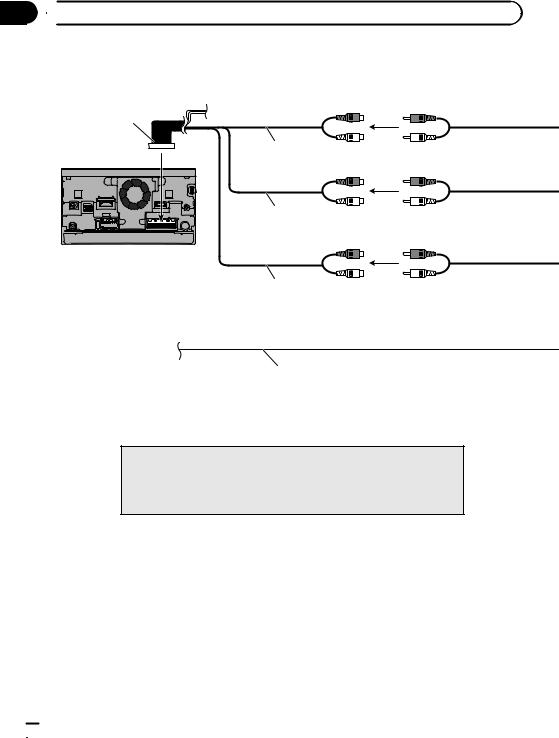
Section
02  Connecting the system
Connecting the system
When connecting to separately sold power amp
Subwoofer outputs (SUB WOOFER OUTPUT)
RCA connector
25 cm
The navigation unit
Rear outputs (REAR OUTPUT)
30 cm
Front outputs (FRONT OUTPUT)
30 cm
Blue/white
To system control terminal of the power amp (max. 300 mA 12 V DC).
For connection, refer to the wiring and installation manual separately supplied.
 Notes
Notes
·You can change the RCA output of the subwoofer depending on your subwoofer system. (Refer to Operation Manual.)
·The subwoofer output of this navigation system is monaural.
 12
12 Engb
Engb
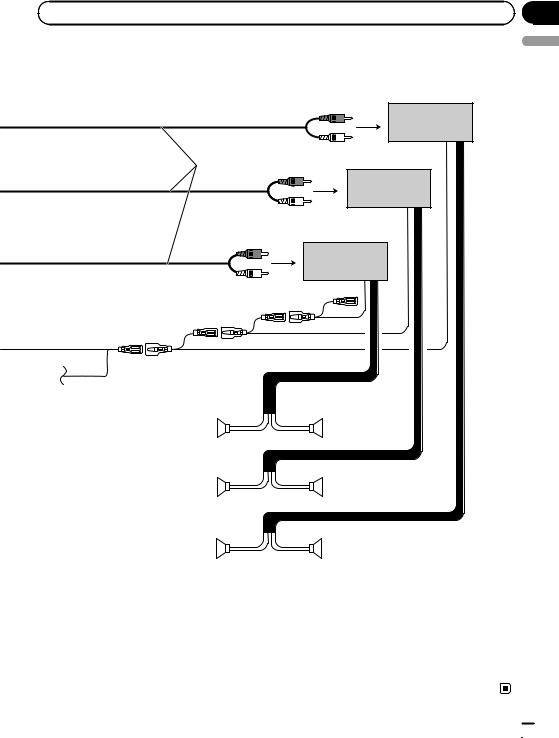
|
Section |
Connecting the system |
02 |
|
English |
|
Power amp |
|
(sold separately) |
RCA cables |
|
(sold separately) |
|
|
Power amp |
|
(sold separately) |
Power amp (sold separately)
|
System remote control |
|
If your vehicle is |
Left |
Right |
equipped with an |
||
auto-aerial, connect |
|
|
this lead to a power |
Front speaker |
Front speaker |
amp. |
|
|
|
|
|
|
Rear speaker |
Rear speaker |
|
|
|
|
|
|
|
Subwoofer |
Subwoofer |
|
|
|
Engb  13
13
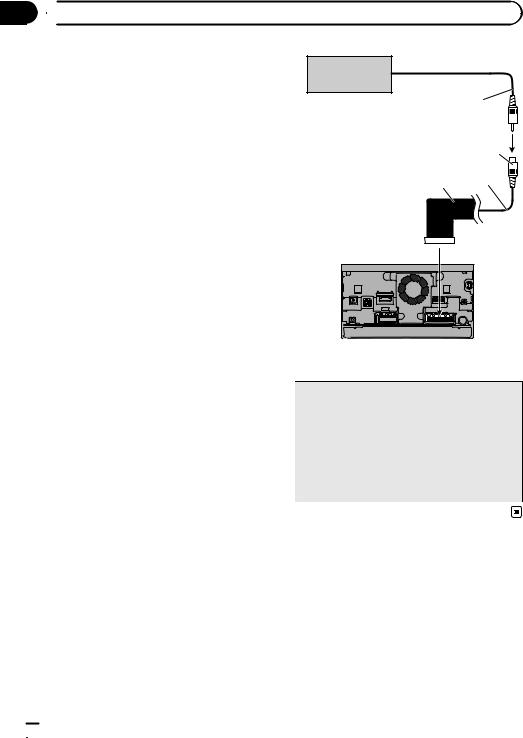
Section
02  Connecting the system
Connecting the system
When connecting a rear |
Rear view camera |
|
|
view camera |
(e.g. ND-BC6) |
|
|
(sold separately) To video output |
|||
When this product is used with a rear view |
|
RCA cable |
|
camera, it is possible to automatically switch |
|
||
|
|
||
from the video to rear view image when the |
|
|
|
gearstick is moved to REVERSE (R). Rear |
Brown |
|
|
View mode also allows you to check what is |
(REAR VIEW CAMERA IN) |
||
behind you while driving. |
RCA |
20 cm |
|
When you use a rear view camera, please be |
|||
connector |
|||
|
|||
sure to connect the violet/white lead. Other- |
|
|
|
wise the rear view camera picture will not ap- |
|
|
|
pear automatically when the vehicle is |
|
|
|
reversing. |
|
|
|
Instructions for proper connection of the vio- |
|
|
|
let/white lead are contained in the wiring and |
|
|
|
installation manual that is supplied separately. |
|
|
|
 WARNING
WARNING
USE INPUT ONLY FOR REVERSE OR MIRROR IMAGE REAR VIEW CAMERA. OTHER USE MAY RESULT IN INJURY OR DAMAGE.
 CAUTION
CAUTION
!The screen image may appear reversed.
!The rear view camera is used as an aid to keep an eye on trailers, or backing into a tight parking spot. Do not use this function for entertainment purposes.
!Objects in rear view may appear closer or more distant than in reality.
!Please note that the image area shown by the rear view camera may differ slightly when fullscreen images are displayed when backing and when checking the rear of the vehicle while moving forward.
The navigation unit
 Notes
Notes
!This mode is available when the rear view camera setting is set to “On”. (For details, refer to Operation Manual.)
!Connect the navigation system to the rear view camera only. Do not connect to any other equipment.
 14
14 Engb
Engb
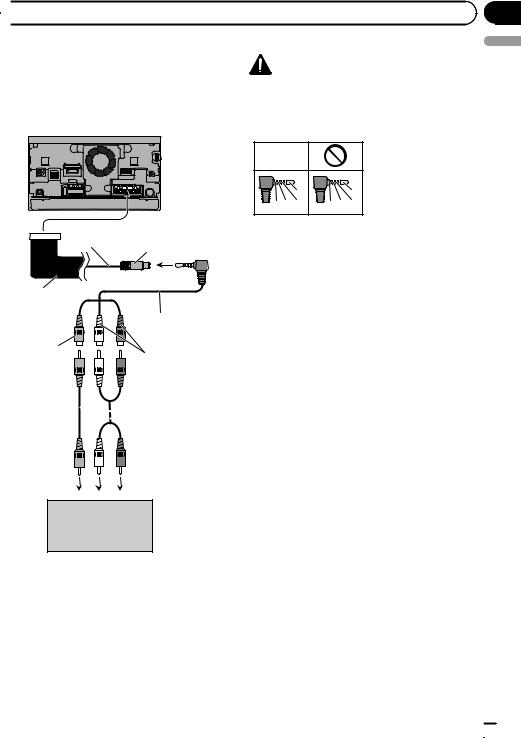
 Connecting the system
Connecting the system
When connecting the |
CAUTION |
|
external video component |
||
Be sure to use a mini-jack AV cable (CD-RM10) |
||
Using an AV input (AV1) |
(sold separately) for wiring. If you use other |
|
cables, the wiring position might differ resulting |
||
|
||
The navigation unit |
in disturbed images and sounds. |
15 cm
RCA connector
Yellow
OK |
|
|
|
|
L : Left audio (White) |
L |
L |
R : Right audio (Red) |
V G R |
R G V |
V : Video (Yellow) |
G : Earth |
AUX input
Mini-jack AV cable (CD-RM10)
(sold separately)
Red, white
 RCA cables (sold separately)
RCA cables (sold separately)
To video output |
To audio outputs |
Section
02
English
External video component (sold separately)
!This mode is available when the setting of video input 1 (AV1) is set to “On”. (For details, refer to Operation Manual.)
Engb  15
15
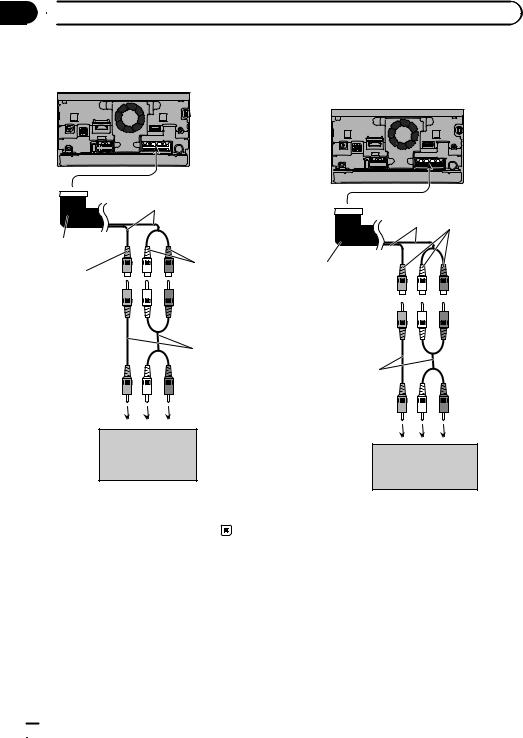
Section
02  Connecting the system
Connecting the system
Using an AV input (AV2) |
When connecting the rear |
The navigation unit |
display |
|
The navigation unit |
20 cm |
|
|
Red, white, yellow |
|
|
|
(REAR MONITOR |
||
|
|
15 cm |
||
|
|
OUTPUT) |
||
RCA connector |
|
|
|
|
|
Red, white |
|
|
|
Yellow |
(AUDIO INPUT) |
RCA connector |
|
|
|
|
|
||
(VIDEO INPUT) |
|
|
|
|
|
RCA cables |
|
|
|
|
(sold separately) |
|
|
|
|
|
RCA cables |
|
|
|
|
(sold separately) |
|
|
To video output |
To audio outputs |
|
|
|
|
|
To video input |
To audio inputs |
|
External video |
|
|
|
|
component |
|
Rear display with |
||
(sold separately) |
||||
RCA input jacks |
||||
|
|
|||
!This mode is available when the setting of video input 2 (AV2) is set to “On”. (For de-
tails, refer to Operation Manual.) |
When using a rear display |
|
connected to rear video output |
 WARNING
WARNING
NEVER install the rear display in a location that enables the driver to watch the video source while driving.
This navigation system’s rear video output is for connection of a display to enable passengers in the rear seats to watch the video source.
 16
16 Engb
Engb

 Installation
Installation
Precautions before |
buttons or (iii) impair the driver’s ability |
|
installation |
to safely operate the vehicle. |
|
! Install the navigation system between the |
||
|
||
CAUTION |
driver’s seat and front passenger seat so |
|
that it will not be hit by the driver or pas- |
||
! Never install this product in places where, |
||
senger if the vehicle stops quickly. |
||
or in a manner that: |
||
! Never install the navigation system in |
||
— Could injure the driver or passengers if |
||
front of or next to the place in the dash- |
||
the vehicle stops suddenly. |
||
board, door, or pillar from which one of |
||
— May interfere with the driver’s opera- |
||
your vehicle’s airbags would deploy. |
||
tion of the vehicle, such as on the floor |
||
Please refer to your vehicle’s owner’s |
||
in front of the driver’s seat, or close to |
||
manual for reference to the deployment |
||
the steering wheel or gearstick. |
||
area of the frontal airbags. |
||
! Make sure there is nothing behind the |
||
! Failure to follow all of these precautions |
||
dashboard or panelling when drilling |
||
may result in serious injury or death. |
||
holes in them. Be careful not to damage |
||
|
||
fuel lines, brake lines, electronic compo- |
|
|
nents, communication wires or power |
To avoid electromagnetic |
|
cables. |
||
! When using screws, do not allow them to |
interference |
|
come into contact with any electrical lead. |
In order to prevent interference, set the follow- |
|
Vibration may damage wires or insulation, |
||
ing items as far as possible from this naviga- |
||
leading to a short circuit or other damage |
||
tion system, other cables or leads: |
||
to the vehicle. |
||
! FM, MW/LW aerial and its lead |
||
! To ensure proper installation, use the sup- |
||
! GPS aerial and its lead |
||
plied parts in the manner specified. If any |
||
In addition, you should lay or route each aerial |
||
parts other than the supplied ones are |
||
lead as far as possible from other aerial leads. |
||
used, they may damage internal parts of |
||
Do not bind, lay or route them together, or |
||
this product or they may work loose and |
||
cross them. Electromagnetic noise will in- |
||
the product may become detached. |
||
crease the potential for errors in the vehicle’s |
||
! It is extremely dangerous to allow cables |
||
location display. |
||
to become wound around the steering col- |
||
|
||
umn or gearstick. Be sure to install this |
|
|
product, its cables, and wiring away in |
Before installing |
|
such so that they will not obstruct or hin- |
||
der driving. |
! Consult with your nearest dealer if installa- |
|
! Make sure that leads cannot get caught in |
tion requires drilling holes or other modifi- |
|
a door or the sliding mechanism of a seat, |
cations of the vehicle. |
|
resulting in a short circuit. |
! Before making a final installation of this |
|
! Please confirm the proper function of |
product, temporarily connect the wiring to |
|
your vehicle’s other equipment after in- |
confirm that the connections are correct |
|
stallation of the navigation system. |
and the system works properly. |
|
! Do not install this navigation system |
|
|
where it may (i) obstruct the driver’s vi- |
|
|
sion, (ii) impair the performance of any of |
|
|
the vehicle’s operating systems or safety |
|
|
features, including airbags, hazard lamp |
|
Section
03
English
Engb  17
17
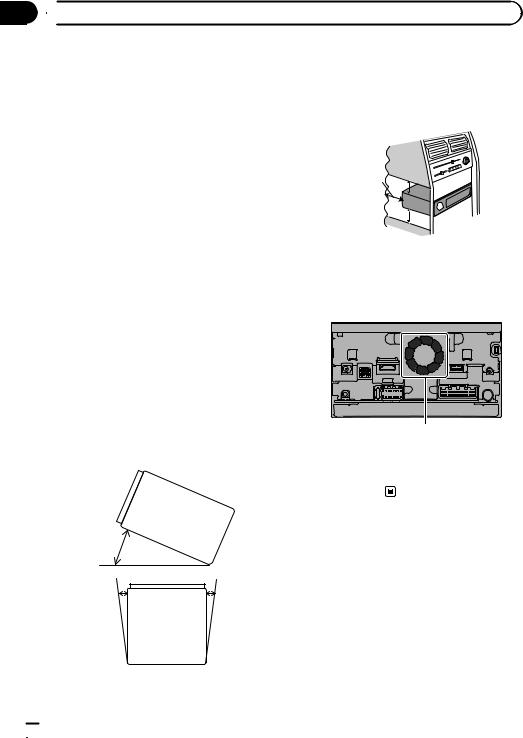
Section
03  Installation
Installation
Installing the navigation |
! When installing, to ensure proper heat dis- |
||
system |
persal when using this unit, make sure you |
||
leave ample space behind the rear panel |
|||
|
|||
Installation notes |
and wrap any loose cables so they are not |
||
! Do not install the navigation system in |
blocking the vents. |
||
|
|
||
places subject to high temperatures or hu- |
|
|
|
midity, such as: |
|
|
|
— Places close to a heater, vent or air con- |
|
|
|
ditioner. |
Leave ample |
5 cm |
|
— Places exposed to direct sunlight, such |
space |
||
|
|||
as on top of the dashboard. |
|
5 cm |
|
— Places that may be exposed to rain, |
|
||
|
|
||
such as close to the door or on the vehi- |
|
|
|
cle’s floor. |
|
|
|
! Install this navigation system in an area |
! The cords must not cover the area shown |
||
strong enough to bear its weight. Choose a |
|||
in the figure below. This is necessary to |
|||
position where this navigation system can |
|||
allow the amps and navigation mechanism |
|||
be firmly installed, and install it securely. If |
|||
to dissipate heat. |
|||
this navigation system is not securely in- |
|||
|
|
||
stalled, the current location of the vehicle |
|
|
|
cannot be displayed correctly. |
|
|
|
! Install the navigation unit horizontally on a |
|
|
|
surface within 0 to 30 degrees tolerance |
|
|
|
(within 5 degrees to the left or right). Impro- |
|
|
|
per installation of the unit with the surface |
|
|
|
tilted more than these tolerances increases |
|
|
|
the potential for errors in the vehicle’s loca- |
Do not cover this area. |
||
tion display, and might otherwise cause re- |
|||
! The semiconductor laser will be damaged |
|||
duced display performance. |
|||
if it overheats, so don’t install the naviga- |
|||
|
|||
|
tion unit anywhere hot — for instance, near |
||
|
a heater outlet. |
|
|
30°
5° |
5° |
 18
18 Engb
Engb
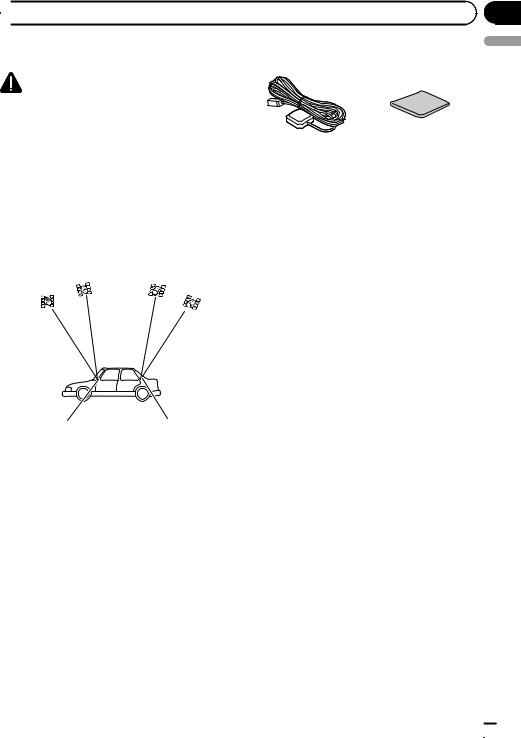
 Installation
Installation
Installing the GPS aerial |
Parts supplied |
|
CAUTION |
|
|
Do not cut the GPS aerial lead to shorten it |
|
|
or use an extension to make it longer. Alter- |
|
|
ing the aerial cable could result in a short cir- |
GPS aerial |
Metal sheet |
cuit or malfunction and permanent damage |
||
to the navigation system. |
|
|
Installation notes
!The aerial should be installed on a level surface where radio waves will be blocked as little as possible. Radio waves cannot be received by the aerial if reception from the satellite is blocked.
Section
03
English
Dashboard |
|
|
|
Rear shelf |
!When installing the GPS aerial inside the vehicle, be sure to use the metal sheet provided with your system. If this is not used, the reception sensitivity will be poor.
!Do not cut the accessory metal sheet. This would reduce the sensitivity of the GPS aerial.
!Take care not to pull the aerial lead when removing the GPS aerial. The magnet attached to the aerial is very powerful, and the lead may become detached.
!Do not paint the GPS aerial, as this may affect its performance.
Engb  19
19
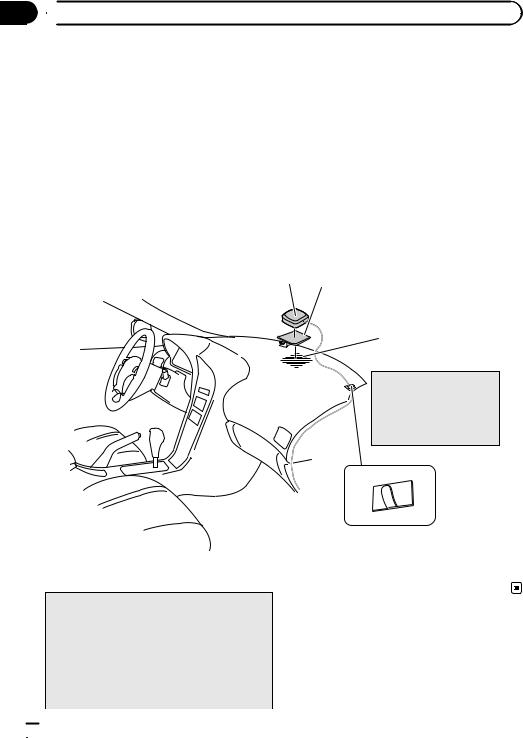
Section
03  Installation
Installation
When installing the aerial inside the vehicle (on the dashboard or rear shelf)
 WARNING
WARNING
Do not install the GPS aerial over any sensors or vents on the dashboard of the vehicle, as doing so may interfere with the proper functioning of such sensors or vents and may compromise the ability of the metal sheet under the GPS aerial to properly and securely affix to the dashboard.
Affix the metal sheet on the surface as level as possible where the GPS aerial faces the window. Place the GPS aerial on the metal sheet. (The GPS aerial is fastened with its magnet.)
GPS aerial
 Notes
Notes
!When attaching the metal sheet, do not cut it into small pieces.
!Some models use window glass that does not allow signals from GPS satellites to pass through. On such models, install the GPS aerial on the outside of the vehicle.
Metal sheet
Peel off the protective sheet on the rear.
Make sure the surface is free of moisture, dust, grime, oil, etc., before affixing the metal sheet.
 Note
Note
The metal sheet contains a strong adhesive which may leave a mark on the surface if it is removed.
Clamps
Use separately sold clamps
to secure the lead where necessary inside the vehicle.
 20
20 Engb
Engb

 Installation
Installation
Installing the microphone |
2 Attach the microphone clip to the sun |
|
! Install the microphone in a place where its |
visor. |
|
Microphone clip |
||
direction and distance from the driver |
||
make it easiest to pick up the driver’s voice. |
|
|
! Make sure to connect the microphone to |
|
|
the navigation system after the system is |
|
|
turned off (ACC OFF). |
|
Parts supplied
Section
03
English
Microphone |
Double-sided tape |
Mounting on the sun visor
1 Fit the microphone lead into the groove.
Microphone lead
Groove
Clamps
Use separately sold clamps to secure the lead where necessary inside the vehicle.
Install the microphone on the sun visor when it is in the up position. It cannot recognise the driver’s voice if the sun visor is in the down position.
Engb  21
21
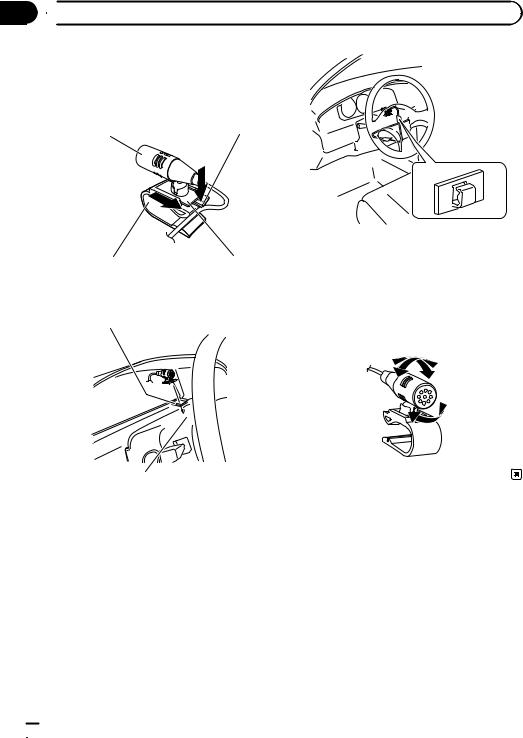
Section
03  Installation
Installation
Installation on the steering column
1 Detach the microphone base from the microphone clip by sliding the microphone base while pressing the tab.
Microphone |
Tab |
|
|
||
|
Microphone clip |
Microphone base |
2 Mount the microphone on the steering column.
Clamps
Use separately sold clamps to secure the lead where necessary inside the vehicle.
Double-sided tape |
Adjusting the microphone angle |
|
The microphone angle can be adjusted. |
Install the microphone on the steering column, keeping it away from the steering wheel.
 22
22 Engb
Engb

 Sommaire
Sommaire
 Précautions
Précautions
Votre nouveau système de navigation et ce manuel 24
Importantes mesures de sécurité 24
 Branchement du système
Branchement du système
Précautions à prendre avant de brancher le système 26
Avant d’installer ce produit 26 Pour éviter toute détérioration 27
– Remarque concernant le fil bleu/ blanc 27
–Remarque concernant le câble violet/ blanc 27
Pièces fournies |
28 |
|
|
|
||
Installation du support pour câble |
|
|
||||
HDMI® |
28 |
|
|
|
|
|
Branchement du système 30 |
|
|
|
|||
Lors de la connexion de l’appareil |
|
|
||||
Android™ |
32 |
|
|
|
|
|
Branchement d’un amplificateur de |
|
|||||
puissance vendu séparément |
34 |
|
||||
Branchement d’une caméra de |
|
|
|
|||
rétrovisée |
36 |
|
|
|
|
|
Branchement d’un élément vidéo |
|
|
||||
externe |
37 |
|
|
|
|
|
– Utilisation d’une entrée AV (AV1) |
37 |
|||||
– Utilisation d’une entrée AV (AV2) |
38 |
|||||
Branchement de l’écran arrière |
38 |
|
||||
– Utilisation d’un écran arrière raccordé |
||||||
à la sortie vidéo arrière 38 |
|
|
||||
Installation |
|
|
|
|
|
|
Précautions à prendre avant |
|
|
|
|||
l’installation |
39 |
|
|
|
||
Pour éviter les parasites |
|
|
|
|||
électromagnétiques 39 |
|
|
|
|||
Avant de procéder à l’installation |
40 |
|
||||
Installation du système de navigation |
40 |
|||||
– Remarques sur l’installation |
40 |
|
||||
Installation de l’antenne GPS |
42 |
|
|
|||
– Remarques sur l’installation |
42 |
|
||||
– Pièces fournies 42
–Installation de l’antenne dans le véhicule (sur le tableau de bord ou la
|
lunette arrière) |
43 |
Installation du microphone 44 |
||
– |
Pièces fournies |
44 |
– |
Installation sur le pare-soleil 44 |
|
– |
Installation sur la colonne de |
|
|
direction 45 |
|
– |
Réglage de l’angle du microphone 46 |
|
Français
Fr  23
23

Section
01  Précautions
Précautions
Votre nouveau système de |
Importantes mesures de |
navigation et ce manuel |
sécurité |
!La fonction de navigation de ce produit (et la caméra de rétrovisée en option le cas échéant) est uniquement destinée à vous assister lors de la conduite de votre véhicule. Elle n’autorise en aucun cas un relâchement de votre attention, de votre jugement et de votre vigilance pendant la conduite.
!N’utilisez jamais ce système de navigation en cas d’urgence pour vous rendre à l’hôpital ou dans une station de police. Veuillez le cas échéant appeler le numéro d’urgence du service concerné.
!N’utilisez pas ce système de navigation (ou la caméra de rétrovisée en option le cas échéant) si celui-ci risque d’une façon ou d’une autre de détourner votre attention. Observez toujours les règles de sécurité et respectez toujours les réglementations de la circulation routière en vigueur. Si vous éprouvez des difficultés à utiliser le système ou à lire l’écran, garez votre véhicule en lieu sûr et serrez le frein à main avant d’effectuer les réglages nécessaires.
!Ce manuel explique comment installer le système de navigation dans votre véhicule. Cependant, certains câblages et procédés d’installation sont décrits dans le manuel d’installation séparé. Le fonctionnement du système de navigation est expliqué dans un manuel séparé.
!N’installez pas ce produit dans un endroit où il risque (i) d’entraver la visibilité du conducteur, (ii) d’altérer le fonctionnement de certains systèmes de commande des dispositifs de sécurité du véhicule, y compris les airbags ou les touches de feux de détresse, ou (iii) d’empêcher le conducteur de conduire le véhicule en toute sécurité. Dans certains cas, il peut ne pas être possible d’installer ce produit en raison du
type de véhicule ou de la forme de l’intérieur du véhicule.
 AVERTISSEMENT
AVERTISSEMENT
Pioneer vous déconseille d’installer vousmême votre système de navigation. Ce produit est conçu pour une installation professionnelle uniquement. Nous vous recommandons de confier l’installation uniquement à un personnel de service Pioneer agréé, qui a été spécialement formé et est expérimenté en matière de systèmes électroniques mobiles, de montage et d’installation de ce type de produit. NE TENTEZ JAMAIS D’EFFECTUER VOUS-MÊME L’ENTRETIEN OU DE DÉPANNER CE SYSTÈME DE NAVIGATION. L’installation ou l’entretien de ce produit et des câbles de raccordement vous expose à des décharges électriques ou autres dangers, et risque de provoquer des détériorations du système de navigation non couvertes par la garantie.
!Lisez attentivement le contenu de ce manuel avant d’installer votre système de navigation.
!Conservez ce manuel à portée de main pour vous y reporter ultérieurement.
!Tenez compte de tous les avertissements formulés dans ce manuel et respectez soigneusement les consignes.
!Dans certaines circonstances, ce système de navigation peut afficher des informations erronées sur la position de votre véhicule, la distance des objets affichés à l’écran et les directions de la boussole. En outre, le système comporte certaines limitations, notamment l’incapacité de signaler les rues à sens unique, les restrictions temporaires à la circulation et les zones où la circulation peut devenir dangereuse. Veuillez vous en remettre à votre bon jugement en fonction des conditions réelles de conduite.
 24
24 Fr
Fr

 Précautions
Précautions
!Comme tout autre accessoire de l’habitacle, le système de navigation ne doit pas détourner votre attention ni nuire à la sécurité de la conduite sous peine d’entraîner des blessures graves voire mortelles. Si vous éprouvez des difficultés à utiliser le système ou à lire l’écran, effectuez les réglages nécessaires après vous être garé dans un endroit sûr.
!Veillez à toujours porter votre ceinture de sécurité sur la route. En cas d’accident, le port de la ceinture peut réduire considérablement la gravité des blessures.
!Certaines lois nationales ou gouvernementales peuvent interdire ou restreindre l’emplacement et l’utilisation de ce système dans votre véhicule. Veuillez vous conformer à toutes les lois et réglementations en vigueur concernant l’utilisation, l’installa-
tion et le fonctionnement de votre système de navigation.
Section
01
Français
Fr  25
25
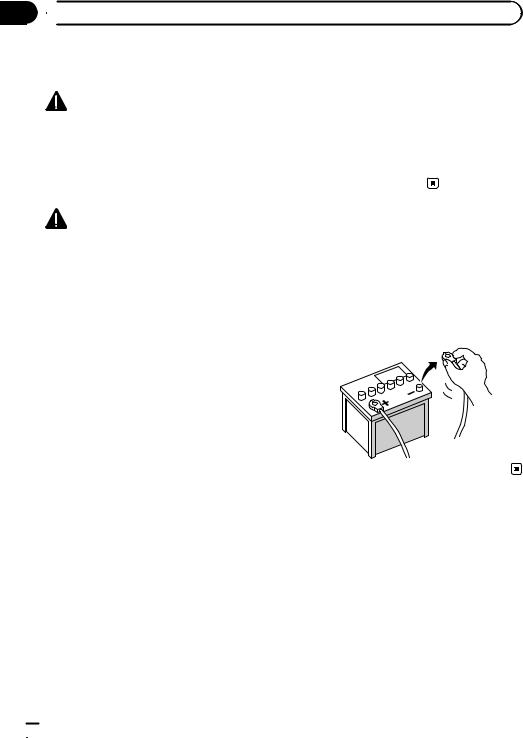
Section
02  Branchement du système
Branchement du système
Précautions à prendre avant |
! Ne raccourcissez aucun fil conducteur. |
|
de brancher le système |
Vous risqueriez autrement de provoquer |
|
un dysfonctionnement du circuit de pro- |
||
|
||
AVERTISSEMENT |
tection (porte-fusibles, résistance de fu- |
|
sible ou filtre, etc.). |
||
N’essayez pas de modifier ou désactiver le |
||
! N’utilisez jamais le cordon d’alimentation |
||
système de verrouillage du frein à main, le- |
||
du système d’alimentation pour raccorder |
||
quel est installé pour votre protection. La mo- |
||
d’autres appareils électriques. La capacité |
||
dification ou la désactivation du système de |
||
du cordon serait dépassée, ce qui provo- |
||
verrouillage du frein à main peut entraîner |
||
querait une surchauffe. |
||
des blessures graves, voire mortelles. |
||
|
||
ATTENTION |
Avant d’installer ce produit |
|
! Si vous décidez de réaliser l’installation |
! Utilisez cet appareil uniquement avec une |
|
vous-même, et possédez une expérience |
||
spéciale en installation d’électronique au- |
batterie de 12 V, avec pôle négatif à la |
|
tomobile, veuillez suivre attentivement |
masse. Sinon, cela pourrait entraîner un in- |
|
toutes les étapes du manuel d’installa- |
cendie ou un mauvais fonctionnement. |
|
tion. |
! Afin d’éviter tout risque de court-circuit, dé- |
|
! Attachez tous les fils avec des colliers ou |
branchez le câble de la borne négative (–) |
|
des serre-câbles. Ne laissez aucun fil à nu. |
de la batterie avant de commencer la pose. |
|
! Il est extrêmement dangereux de laisser |
|
|
les câbles s’enrouler autour de la colonne |
|
|
de direction ou du levier de vitesse. Assu- |
|
|
rez-vous d’installer ce produit, ses câbles |
|
|
et les fils de telle façon qu’ils n’obstruent |
|
|
ni ne gênent la conduite. |
|
!Veillez à ce que la trajectoire des câbles et des fils n’interfère pas avec les pièces en mouvement du véhicule. Fixez les câbles de manière à les empêcher d’être happés par, notamment, le volant, le levier de vitesse, le frein à main, les glissières de siège, les portes, ou tout autre élément de commande du véhicule.
!La trajectoire des fils ne doit pas être exposée à des températures élevées. Si l’isolation chauffe, les fils risquent d’être endommagés, ce qui peut entraîner un court-circuit ou un dysfonctionnement, et endommager de manière irrémédiable le produit.
!Ne coupez pas le câble de l’antenne GPS et n’utilisez pas de rallonge. Une telle modification pourrait provoquer un court-cir- cuit ou un dysfonctionnement.
 26
26 Fr
Fr
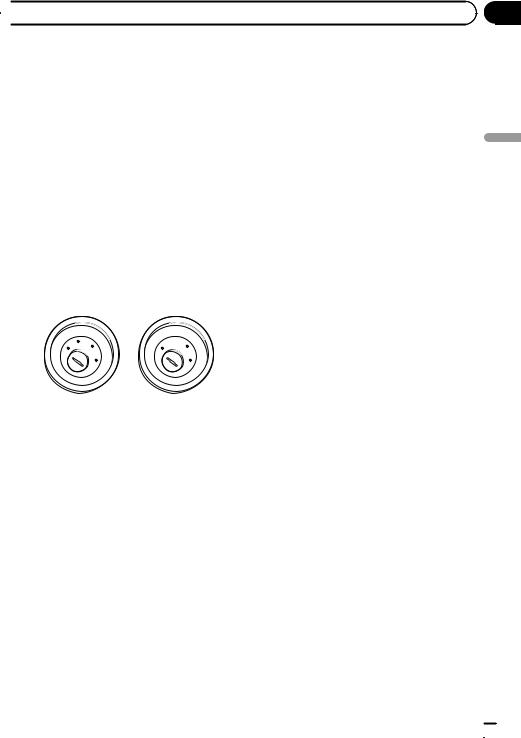
 Branchement du système
Branchement du système
Pour éviter toute détérioration
 AVERTISSEMENT
AVERTISSEMENT
!Utilisez des haut-parleurs de plus de 50 W
(valeur de sortie) et avec une impédance comprise entre 4 W et 8 W. N’utilisez pas de haut-parleurs 1 W à 3 W avec cet appareil.
!Lors du remplacement du fusible, veillez à utiliser seulement un fusible du calibre indiqué sur ce produit.
!Pour débrancher un connecteur, tirez le connecteur proprement dit et non son fil pour éviter de l’arracher.
!Ce produit ne peut pas être installé dans un véhicule qui ne possède pas de position ACC (accessoire) sur le commutateur d’allumage.
|
CC |
|
|
|
|
F |
A |
O |
|
F |
O |
|
|
||||
|
N |
N |
|||
F |
|
|
|
F |
|
O |
|
|
|
O |
|
|
|
|
S |
|
S |
|
|
|
T |
|
T |
|
|
|
A |
|
A |
|
|
T |
R |
|
T |
Position ACC |
Pas de position |
||||
|
|
|
|
|
ACC |
!Pour éviter les courts-circuits, recouvrez les fils déconnectés de ruban isolant. Il est particulièrement important d’isoler tous les fils conducteurs de haut-parleurs non utilisés pour éviter tout risque de court-circuit.
!Pour raccorder l’amplificateur de puissance à d’autres unités, veuillez vous reporter au mode d’emploi concerné.
!Un circuit BPTL unique étant employé, ne reliez pas directement l’extrémité du fil conducteur de haut-parleur * ou ne reliez pas les extrémités des fils conducteurs de haut-parleur * ensemble. Veillez à relier l’extrémité * du fil conducteur de haut-par- leur à l’extrémité * du fil conducteur de
haut-parleur de ce système de navigation.
Section
02
Remarque concernant le fil bleu/blanc
! Lorsque le commutateur d’allumage est |
|
sur Marche (ACC ON), un signal de |
|
commande est émis par le biais du fil bleu/ |
|
blanc. Raccordez-le à une borne de |
|
commande à distance du système d’ampli- |
Français |
tique du véhicule ou au terminal de |
|
ficateur de puissance externe, à la prise de |
|
commande de relais de l’antenne automa- |
|
commande d’alimentation de l’amplifica- |
|
teur d’antenne (max. 300 mA 12 VCC). Le si- |
|
gnal de commande est émis par le biais du |
|
fil bleu/blanc, même si la source audio est |
|
désactivée. |
|
!Assurez-vous de ne pas utiliser ce fil comme câble d’alimentation pour les amplificateurs de puissance externes. Une telle connexion pourrait causer un appel de courant excessif et un mauvais fonctionnement.
!Assurez-vous de ne pas utiliser ce fil comme câble d’alimentation pour l’antenne automatique ou l’amplificateur d’antenne. Une telle connexion pourrait causer un appel de courant excessif et un mauvais fonctionnement.
Remarque concernant le câble violet/blanc
Il est nécessaire de raccorder le câble violet/ blanc pour que le système de navigation puisse détecter si le véhicule avance ou recule. Raccordez le câble violet/blanc au câble dont la tension change lorsque le levier de vitesse est placé sur la marche arrière. Sans ce raccordement, le capteur risque de ne pas pouvoir détecter correctement le déplacement en marche avant/arrière de votre véhicule, et par conséquent la position de votre véhicule telle qu’elle est détectée par le capteur risque de ne pas correspondre à votre position réelle.
Fr  27
27
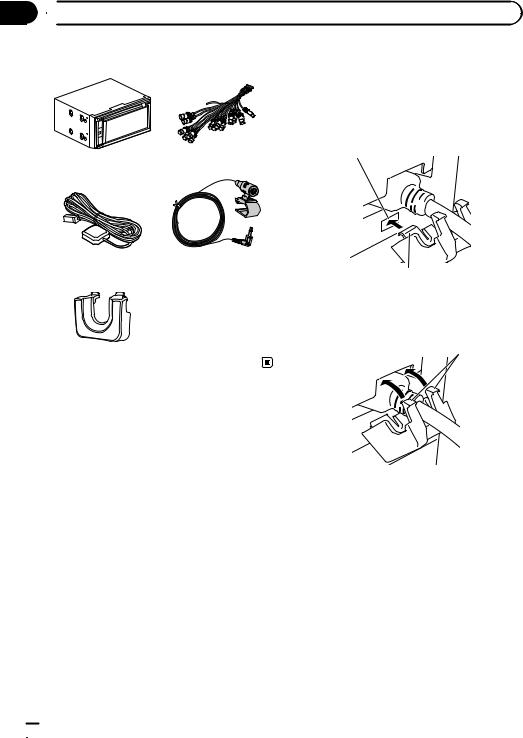
Section
02  Branchement du système
Branchement du système
Pièces fournies |
Installation du support |
|
pour câble HDMI® |
|
1 Insérez la languette inférieure du sup- |
|
port pour câble HDMI dans la fente de ce |
|
produit. |
|
Fente |
Unité de navigation |
Connecteur RCA |
Antenne GPS |
Microphone |
Languette |
Support pour câble HDMI
2 Insérez les deux languettes supérieures dans ce produit en enfonçant le support pour câble HDMI.
Languette
pUtilisez le support pour câble HDMI lorsque vous connectez ce produit avec le Kit de connexion aux applications vendu séparément (CD-AH200).
pNe tenez pas le support serré ni n’utilisez la
force lors du retrait ou de la fixation du panneau.
 28
28 Fr
Fr

|
Section |
Branchement du système |
02 |
Français
Fr  29
29
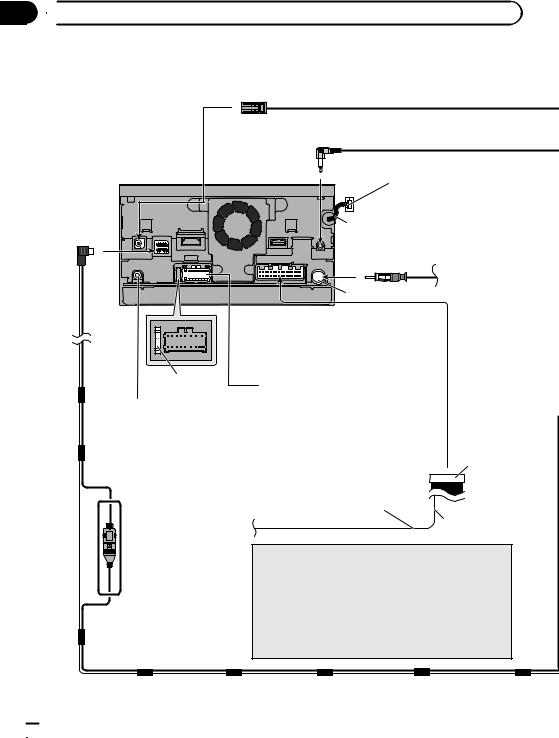
Section
02 Branchement du système Branchement du système
Branchement du système Branchement du système
Unité de navigation
13 cm |
Entrée de l’adaptateur du bus du véhicule
Veuillez vous reporter au mode d’emploi des adaptateurs du bus du véhicule (vendu séparément).
Antenne du véhicule
Prise d’antenne
Fusible (10A)
Entrée à distance câblée Veuillez vous reporter au mode d’emploi de l’adaptateur de commande à distance câblés (vendus séparément).
(*2)
(*2)
Si vous utilisez un périphérique de stockage USB, retirez la fiche et insérez un périphérique de stockage USB.
Cordon d’alimentation
Pour la connexion, consultez le manuel d’installation et de câblage vendu séparément.
Jaune/noir
Si vous utilisez un appareil avec la fonction de sourdine, connectez cet appareil au fil Audio Mute (sourdine). Sinon, laissez ce fil sans connexion.
Connecteur
RCA
15 cm
 Remarque
Remarque
La source audio sera coupée ou atténuée, alors que les sons suivants ne seront pas coupés ou atténués. Pour en savoir plus, consultez le Manuel de fonctionnement.
—guidage vocal de la navigation
—sonnerie entrante et voix entrante du téléphone portable connecté à ce système de navigation via la technologie sans fil Bluetooth®
 30
30 Fr
Fr
